A long, non-story-spoiler review for Lies of P.
(There is a wealth of info about the combat in the game, but nothing beyond that.)
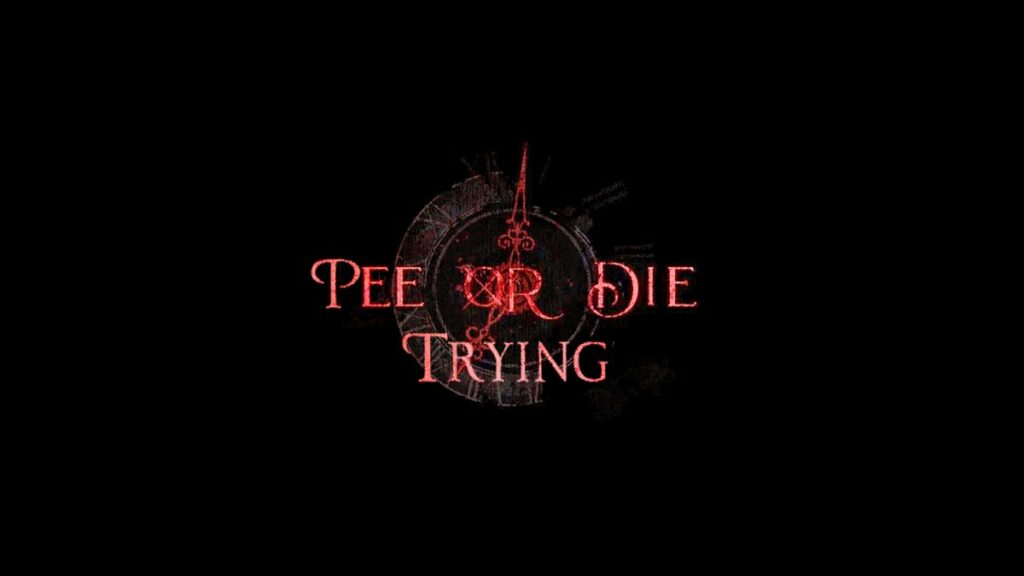
This is not a real death card–I made it in photoshop–but it is what my friends and I were saying non-stop when my friend Rob streamed the game for us a few months back.
THE SHORT OF IT
I waffled on rating this a lot, and while I hate the idea of decimals in a “out of 10” rating, I have to settle on giving it a 7.5/10. 7 was too low, 8 suggested more perfection than is found in the game. But I stand by a 7.5—it’s a score that reflects its flaws and its strengths.
Cause, I’ll be honest, this game hooked me. It’s really, really fun to play, and I think anyone who deeply loves the combat of soulsborne titles will likely love it, too. If you play these games for the lore, however, look elsewhere.
Lies of P has a lot of quality of life features that make it a hair more accessible than proper Fromsoft titles, but the difficulty is still there. I found it on par with Dark Souls 3, which for me has a low, but still satisfying, level of difficultly up until a certain point. The introduction of a perfect parry system gives the fast-paced, Bloodborne-style combat a new edge, and this, paired with a skill tree, the ability to customize weapons, and the lying mechanic in the story part of the game provides players with a huge variety of builds and play styles to try out.
Veteran souls players might find the levels slightly too short, but the level design is well done, as is enemy and boss variation. The setting is a new one—it is not a copy of Bloodborne, and excels most when it’s doing its own thing instead of looking to Fromsoft titles for inspiration. A good soundtrack and diegetic sound and music throughout levels give it a more warm feel than some Fromsoft titles, which is apt for the theme of the game. The story is easy to understand and engage with (a pro to some, a con to others), and quests are not nearly as difficult as those in the Dark Souls series or Elden Ring. Newcomers to soulslike games and veterans alike will find it as rewarding, complicated and satisfying as any soulsborne game.
Its only large flaws are the lack of the weird, the creepy, the fucked up horny and pure masochistic spirit of a true Fromsoft title. The story, its themes, the designs and the writing are all very straightforward, and it would’ve been much better (a masterpiece, if I dare say it) if it let itself get weird and dark and embrace the full potential of wrestling with ideas of humanity through puppets (and the perfect canvas they are for body horror) but again, the combat is so solid that the more shallow writing doesn’t bother me as much as it would if the game wasn’t as much fun to play as it is.
Lies of P is a solid game following the formula of a soulslike very faithfully while developing its own identity and flavor within that framework. It’s hooked me completely, and I’d say it’s worth the full price tag, given its immense replayability, even if it is a little on the short side. I had a great time with my first play through of the game, and I’m already delightedly dreaming up the many builds I’ll use to get that Platinum trophy. (I’m also very interested in their next game, but I won’t spoil what that is—you’ll have to play Lies of P yourself to see what IP they’re doing next.)
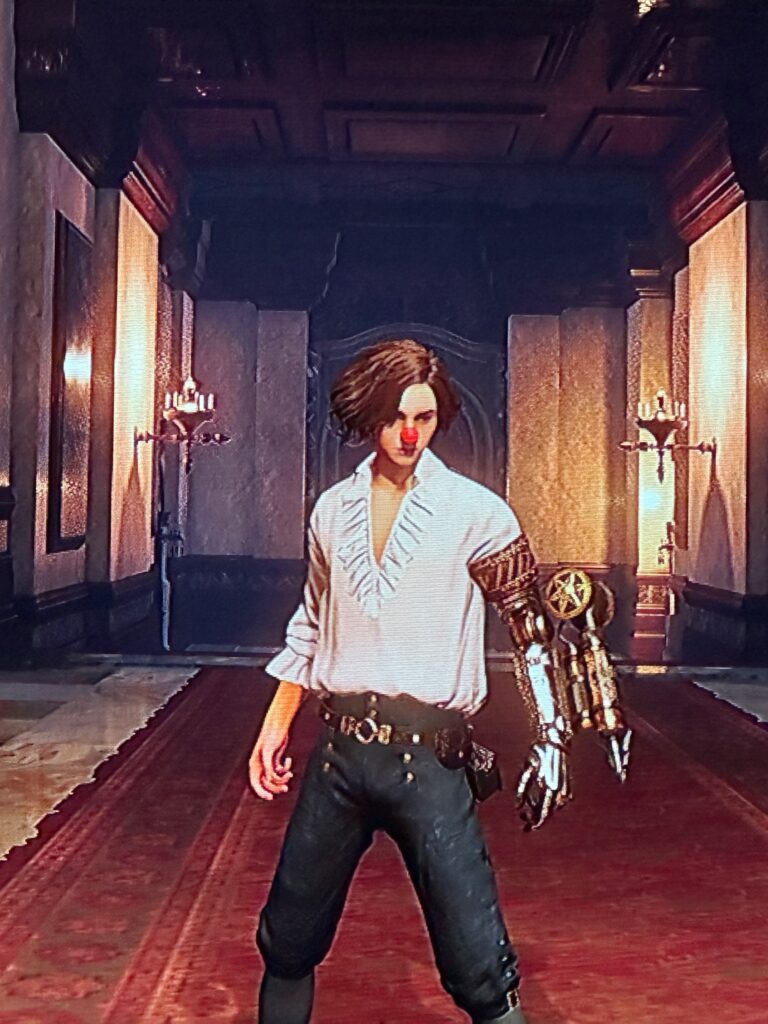
I’ve played the whole game with this “clown nose” on (it’s actually a reindeer nose from a holiday event?? i think?)
OKAY, HERE’S THE BIG LONG REVIEW
To get the first thing out of the way, a lot of this game was really funny because I have what uncharitable people call an “immature sense of humor”. Lies of P on its own is a really funny name. The skill tree leveling system is called the P-organ, and leveling up this skill tree is called “activating your P-organ”. It’s just pure comedy for a guy who played the game entirely in a clown nose and took photos of every toilet they found in the game and shared them in the gamer group chat.
(Yes, everyone enjoyed the toilet photos. And if you were wondering how many toilets are in Lies of P, there are only three. Can you flush them? No. For this, it gets a 6/10 on the toilet score, and Phasmophobia, with its many flushable toilets, reigns supreme.)
The premise of the game alone was also quite funny—why the fuck would you put a puppet based on Pinocchio of all characters in a grim, dark and dim soulsborne-like world? It kept striking me as weird—weird and funny, especially with the game trying its best to incorporate as much as it could from the original story. Levels that reminded me strongly of something from Dark Souls 3 were especially bizarre, because it felt like kinda Dark Soulsy, but… everything in it was an evil puppet? Just a bunch of puppets. It was so bizarrely entertaining. I absolutely loved it.
And well—I suppose the real deep-down answer to this question of why the devs picked Pinocchio for the game is “because Pinocchio is out of copyright” but to be fair to them, as the game went along, I started to understand the why beyond that. And the answer is, basically, why the fuck not? Turns out, it whips total fucking ass to run around Belle Époque Europe as a small killing machine with a blade, a weaponized arm and a passion for lying.
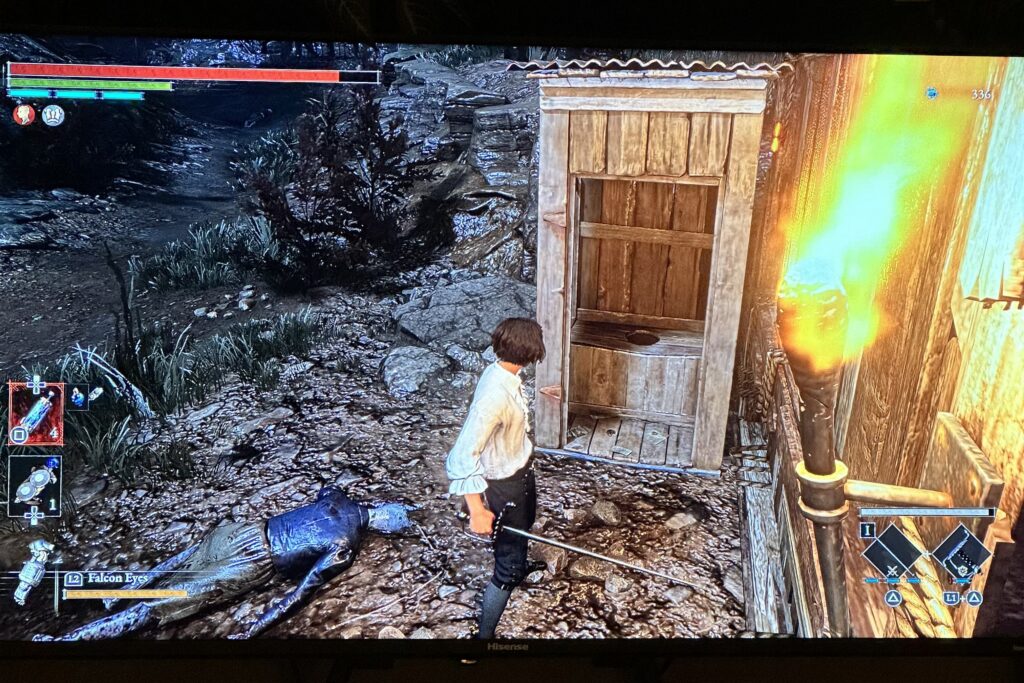
Toilet #1. Scary due to the old-fashioned wooden seat. Never designed initially to be flushable, so maybe the toilet score for Lies of P should be higher. I will think about it.
Is it “Bloodborne 2” as some people were saying in early play testing? Not really—certainly not in theme, for while the influence is highly visible, Lies of P is not a horror game (but more on that later), and while the combat is very similar to Bloodborne with its heavy melee focus, quick attack patterns and the ability to roll and strafe, it introduces a Sekiro-style parry system which broadens the play style considerably, making dodging and getting perfect parries both viable ways to deal with incoming attacks.
The perfect parries were not the way I played the game, as I’m really bad at parrying because I struggle with reaction times. But the idea is fantastic: block at just the right moment, and you block 100% of the incoming damage, as well as build up that invisible stagger bar and have a chance to break a boss’s weapon. If you weren’t perfect with your block timing, you only take some of the damage and can then rally back the health lost.
This ability to rally back health lost during an unsuccessful parry is brilliant, as it encourages players to learn the timings for perfect parries since the risk is so much less than missing a parry in any Fromsoft game (barring Sekiro, maybe? I don’t know). This is by far the smartest thing the game does combat-wise, and one of the small quality of life things scattered throughout the game that make it just slightly (by a hair or two) more accessible than actual soulsborne games.
Another more accessible addition to the soulsborne combat formula is that the game lets you know when you need to get one more charged attack on an enemy to cause a stagger. Their health bar starts flashing white, and that’s your signal to really rush in—however, this can cause an absolute mad frenzy to become reckless trying to get a stagger off. You just might die from this, multiple times, until you learn your lesson to just calm the fuck down.
The Legion Arm (that’s your mechanized left arm weapon) is a fun addition to the Bloodborne-style combat, and I’d probably have more to say about it if I’d played Sekiro. It’s not as usable as a gun in Bloodborne, or spells/miracles/etc in any of the magically inclined games, so a “Legion Arm only” build isn’t viable—you will be doing melee in this game. But it can help out in a pinch by adding some extra ranged physical or elemental damage, some blocking capabilities—or just give you a very cool “puppet string” ability, which can whip you up into the air and land really sick looking aerial attacks if you upgrade the Puppet String arm all the way.
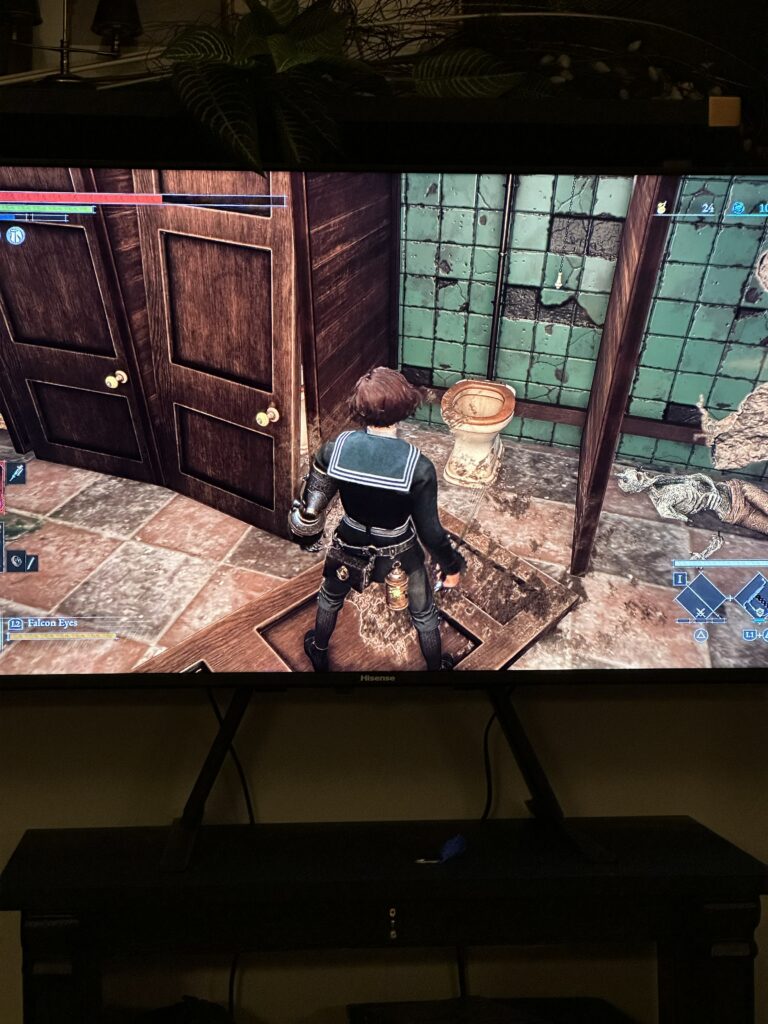
Toilet #2. An old fashioned, high tank toilet, which means this sucker would really flush–if only it could.
And that brings me to something else—the combat in this game is flashier than in soulsborne games, giving us what I would affectionately call a good dose of “anime bullshit”. Cool flips and spins, sound and visual effects when landing fatal attacks, and big beautiful arcs of… black grease. Because you’re mainly fighting puppets and they’re full of oil, not blood. It still looks as cool as blood, though, I promise, and feels just as satisfying.
The exact anime bullshit you end up with is determined by the Fable Art on your weapon. Think Weapon Art from DS3 or Ash of War from ER and you’re on the right track. They come from the handle and the blade itself, some better than others, and you can build up Fable with attacks (mostly charged attacks, I think) or use consumables or perks in the skill tree to get more Fable.
This game doesn’t have transforming weapons like Bloodborne, but it has something just as cool: the ability to swap blades and handles between almost any weapon in the game. Match the damage types and make sure you’ve got the right crank on the handle for your build and you’re good to go. This customization increases the game’s replayability tenfold and helps the player pick a weapon with a move set that suits them, which, just like the anime bullshit, arcs of black grease, and a rare moment (for me) of actually landing a perfect parry makes the combat intensely satisfying.
This is Lies of P’s inarguable strength: it feels great to play. It also looks great to play. I’m not sure why most of the costumes in the game are in an 18th century style, predating the actual setting of the game by at least 100 years, but it does look sick as hell, so no points docked off from me. You can wear a frilly shirt and breeches as you run around the streets of Krat, and I love frilly 18th century shirts, so I’m pleased.
The levels themselves are overall smaller than in Fromsoft games, and do feature some of the winding layout and short-cut goodness we’re used to. However, the shortness made the shortcuts less awe-invoking. You know the feeling—you’re deep in the wynds of Yharnam, lost as all shit and going “dear god there has to be a lantern soon somewhere fucking please I’m almost dead I’m out of heals dear god please” and then… there’s a gate that opens up to the Central Yharnam lamp, and the sight of that damn thing fills you with joy and peace and relief.
Because the levels are shorter, I was rarely at that point of desperation. I found a shortcut and was like “okay, cool, well, that’s there for later I guess” and turned around to keep exploring. Often times the shortcuts felt completely unnecessary, like they were just there because “Fromsoft games have shortcuts”.
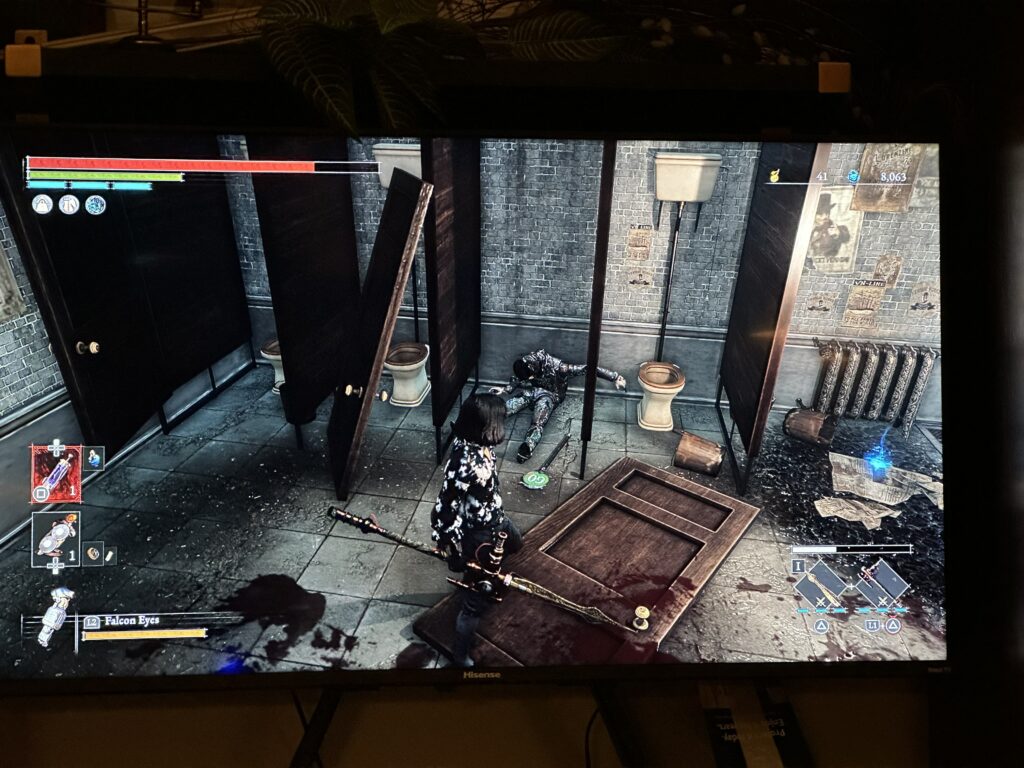
The final toilet, #3. Another old fashioned high tank, but the stall next to it had a guy in it that tried to kill me. Not ideal restroom experience.
The only level that seemed to really have the sprawling, infuriating, confusing and winding Fromsoft level design that we all love was the very last level—but that’s not the say I didn’t enjoy the others. Some levels in Lies of P take clear, unabashed inspiration from Bloodborne and Dark Souls 3 and don’t hide it, and they do a good job at their version of it. (Then again—how can you really re-invent a city layout of this general era for this exact format of a game? To me, Krat did not feel much like Yharnam.)
The best levels, though, took nothing from other Fromsoft games and were entirely their own thing, chosen not because “Fromsoft usually does a level like this”, but because they were entirely relevant to the story of the game. I won’t spoil what they are, but these levels were beautiful, as was the use of atmospheric sound, and diegetic sound and music. The latter I absolutely loved for a feeling of verisimilitude—of course there would be sounds of life in Krat, even if there is a Puppet Frenzy slowly destroying all of it—and it could even be considered a quality of life thing to help less well-oriented players remember where things are on a level. It gave the world fantastic flavor, and I especially loved passing by a section of street that had someone playing a record inside. It’s little things like that that really made the game feel distinct, and gave it a touch that Fromsoft games don’t usually have (which is understandable, as many soulsborne games push the isolation and desolation to extreme degrees.)
This humanity, if you will, and touch of warmth to the setting here and there works extremely well with the theme of the game. We are, after all, a puppet turning into a human, on some level, through the mechanic of lying. I won’t spoil the story’s angle on why this happens, but the more you lie, the more your mechanical heart pounds, and the more human you become. I also won’t spoil what some of these more human details are, because I think they’re really fun to start noticing yourself as you play, but giving the playable character an actual arc in the narrative is something I am not used to in soulsborne games (again, I haven’t played Sekiro), and I loved it.
The story itself is not very complicated, nor is it super surprising or difficult to figure out, which is either a strength or a weakness. If you love soulsborne games for inscrutable, excruciatingly well written lore hidden in items, this is not the game for you. The benefit to the simpler story was that I understood it all, without any effort, and that made me more eager to engage with it every chance I got because 1) I knew why I was doing all of it, and 2) I knew what I was likely to get out of it & what its effects on me and the world would be. At no point in the game did I feel stressed out because I might fuck up an ending or a quest.
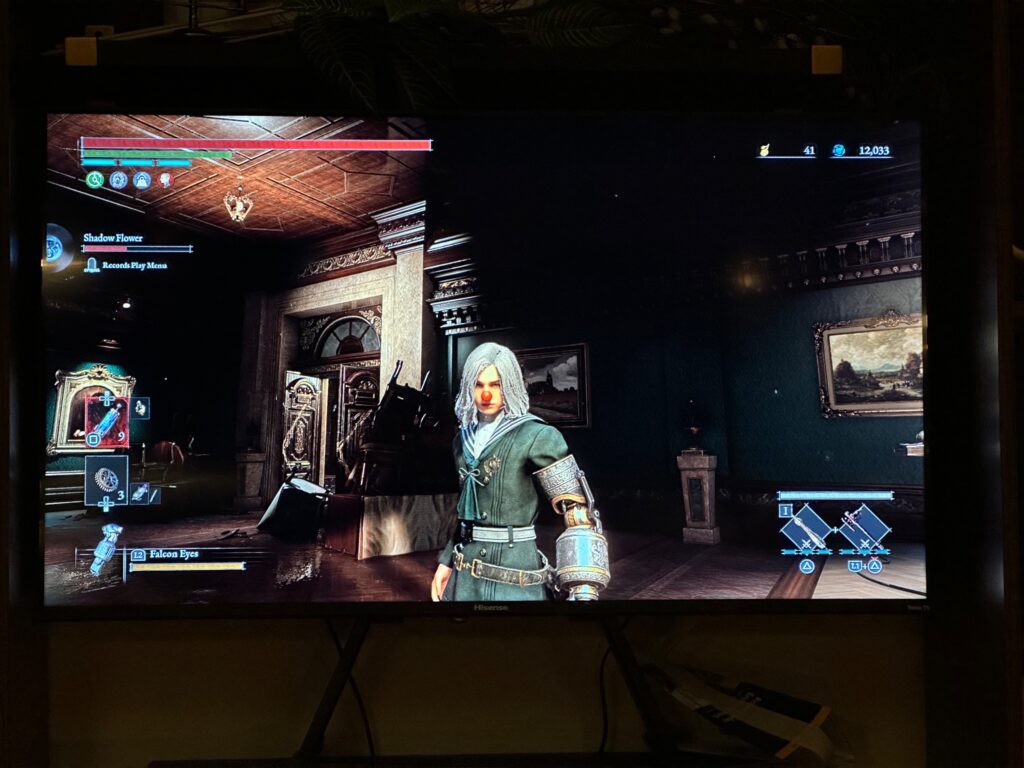
I have run out of toilet photos, so here is P in his “griffith era”, as I call the long silver hair look.
This brings into focus one of the biggest quality of life things in Lies of P: markers and icons show up for where you need to go and who you need to talk to for quest and story progression. It’s not as intense as a quest log, but levels will light up if there’s someone to talk to there, and when the story progresses, icons of characters will appear on their respective locations so you know you need to go talk to them. This was great as someone who experiences a very single-minded brain when it comes to video games. You see, when I’m in a game, I’m there to kill with my big cool weapon, and I am overridden with the bloodlust to kill and destroy with my big cool weapon. I think about the stuff in the game after I have played a session of it and am not overridden with the bloodlust that says I need to go back out there and kill and destroy with my big cool weapon.
So—it depends on the kind of player you are whether or not a simpler story with quest markers will be your jam or not. Undeniably the writing itself—as in the actual script for characters, item descriptions and level names—is not nearly anywhere as good as it is in Fromsoft games. The dialogue was clunky, and the item descriptions and tips on screen felt more like someone had written down the gist of what should be written about… but no one bothered to take those notes and turn them into something well written. Item names did not have the bone-shattering poetry of Bloodborne items, and level names failed to roll off the tongue (“Isabella Rosa Street” still bothers me), and while it might attempt to have some of the Fromsoft sprinkling of archaic English and Latin here and there, it fails to deliver any real obscurity. “Malum District” is all we really get, and it’s too easy and obvious; I took a quarter of Latin in college 17 years ago, and I got a D in it, and I know that “malum” just means ‘evil’.
(I realize that some of this is likely due to the translation & localization team, since I think Lies of P was made by a Korean dev team. The clunkiness is probably the result of more direct translations, which should’ve been fine-tuned and rewritten slightly to sound better in English. I’m not upset about it, but it is harder to stomach when compared to what the game is trying to emulate. I’m hoping they have a better team who will undertake this extra fine tuning for the next game.)
So, we have a story that is told all very much this straight-forward on-the-nose sort of way, and fails to deliver much in the way of poetry, subtlety, or elegance. This is in keeping with the overall art direction of the game, as well, which, apart from also being quite on the nose and straight-forward, fails on two main points: it forgets to design the monstrous with dignity, and it is not freaky fucky creepy horny at all. This, as a weird freaky horny person myself, is a pretty big whiff.
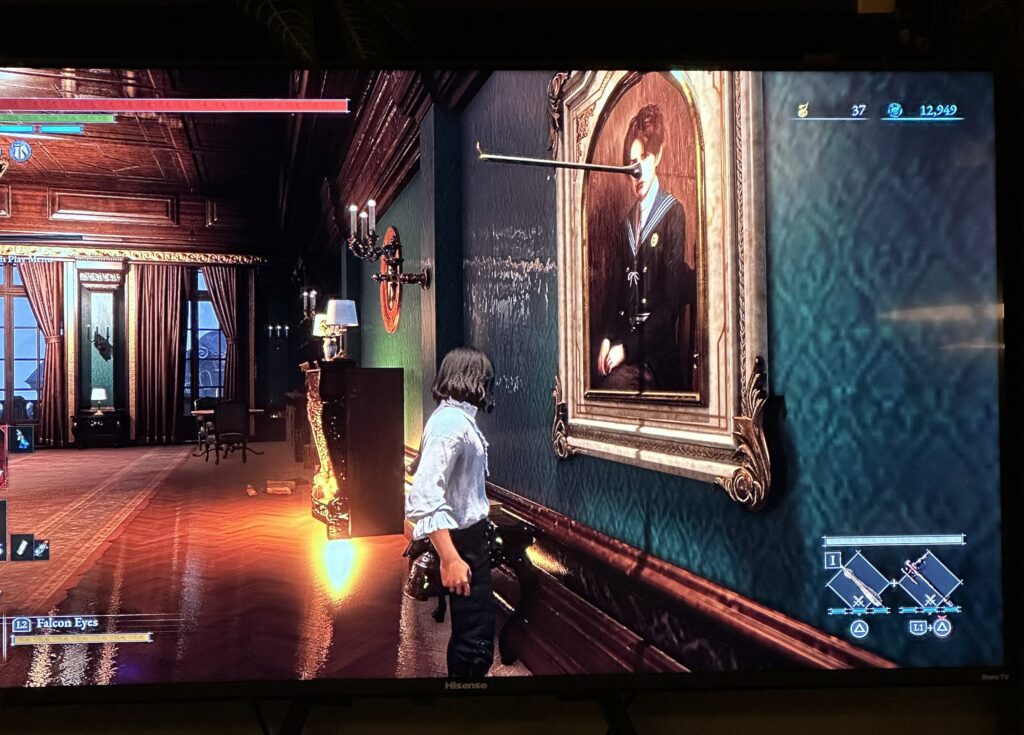
Speaking of whiffs… this happens. Don’t worry about it.
Every opportunity to make the game fucky and horny is missed, as are all the opportunities for body horror. This assessment of mine does imply that I think it should’ve been a true horror game—it is at most a “dark” game, but not horror, and a game about evil puppets and monstrosities and the nature of humanity could be seeping with horny, scary, weird shit, thriving and blooming in the embrace of horror.
Instead of going truly dark and weird, our finely tuned killing machine who sharpens his blade on his own mechanical arm is just a child puppet (who looks thoroughly human through the whole game), and the puppet enemies and bosses are just… kinda like, odd looking mannequins and machines. Odd is probably being generous—they’re a bit busted and grimy, but that’s it. There are a lot of handlebar mustaches as well, which are almost always funny. When monstrosities come in, they’re mainly just lumpy and a bit silly—cartoonish, even—and there’s no better example than the last mandatory boss, who looks like a big potato with arms and a head plonked on there—and then he gets a second phase with a weird glowing “god arm” slapped in there and a second head that looks like a slightly melting cock head. Not in a hot way, either. Or even a funny one… or whatever the hell is going on with Ludwig the Accursed’s blobby, pustule-ridden second mouth(?) in Bloodborne. It’s just like, a glowing cock head for some reason… it fails to disgust or excite me in any fashion.
Fromsoft always hits the nail on the head when it comes to dignity in the monstrous. Bloodborne taught me so much about design, truly, and it is not an exaggeration to say it changed me as an artist. The monsters and machines in Lies of P do not feel like the awe-invoking monstrosities they should be—filing you with an awe that is cognate to “awful”—be they emerging gods or saints, and the machines are not finely crafted killing machines gone wrong, horrible in their elegance and short-circuiting into a horrific capability for destruction that is fixed upon you—you, a small puppet, alone in a crumbling world with your fragile, waking humanity beating inside of you.
Instead they are just like… you know, they’re there. And you fight them. Almost all the bosses have cinematic intros, which I think are well done, and seem to be crafted with much care and pride, but the art direction and overall vibe of the game still lacks the special sauce that Miyazaki and his masochism bring to soulsborne games.
Because the masochism really does matter—you might rail against this and my desire for this game to be horny in this way (granted, I am single, and very bored)—but soulsborne games are games that kill you, over and over, and there is a delight in that. The player delights in this—that is the joyful, willing suffering of a fanbase dedicated, desiring and wanting to be destroyed over and over again. “This is how I want to be killed!” are Miyazaki’s own words regarding the brutality of the souls games. In Lies of P, there is no exquisite martyrdom, no desire to destroy the flesh—which could be woven in beautifully with the game’s theme of humanity, and the inherent ability of the player character, as a puppet, to be destroyed, repaired, and reconfigured.
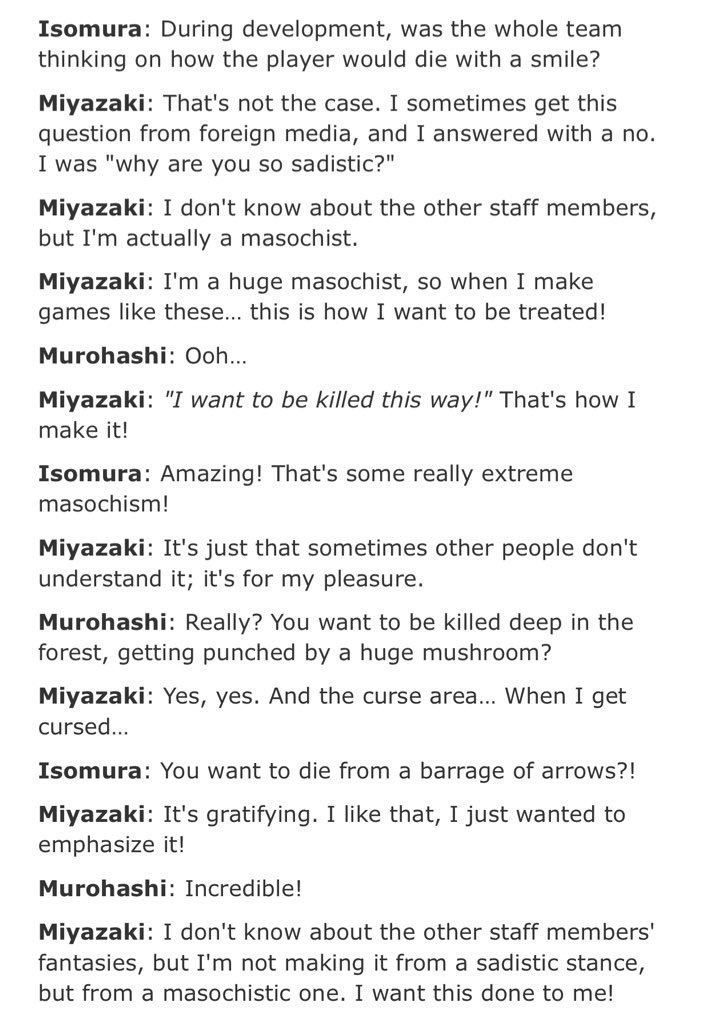
So it is a disappointment that these things are missing in the game. The design that gives dignity to a monster or a machine gives them a veil of humanity, a relatability—they are as important, meaningful, beautiful and as real as I, the player character, am. They are not insignificant. The world is more than me—that is awe-striking, and awful. What is a puppet, a monster, and what is a human? The line is blurred a little in Lies of P, especially towards the end—but there is very little dignity given, visually, to what should be given dignity, and there is no joy in the masochism, or fear for the suffering and destruction—and death and destruction is something a puppet does not naturally fear, for he can be reassembled from spare parts so easily. So, shouldn’t the puppet of Geppetto fear his repeated death and destruction as he becomes more human? Shouldn’t he delight in the destruction as much as he fears it? Shouldn’t the fear be exquisite, as it is such a human thing for a puppet to feel? Does the masochism of Fromsoft games really have no place in this story?
Well, the developers didn’t think so—or it didn’t occur to them. Granted, there are many, many fans of soulsborne games that do not see, understand or appreciate these aspects of the games, and if you told them that this weird, horny, masochistic joy of destruction was a part of every game—even coming from the mouth of Miyazaki himself—they’d look at you like you had three heads. It’s just not on some people’s radar. They just want to have some fun killing monsters, I guess.
Besides the weirdness of masochism, there’s also a lack of more surface-level weirdness. There’s no cryptic laughter, and no NPCs feel really wholly suspicious and evil in the Fromsoft-y way. No one is really battle-worn, insane, or that freakish. We meet, for the most part, a lot of nice people, and voice actors who are doing slightly too peppy and friendly readings of the lines. And, again, nobody’s really hot, partially because almost everyone is just sane and nice. Nobody wanted to get weird in the writing room unfortunately, and for that, Lies of P falls short of being the freakish masterpiece it could’ve been.
The devs also misunderstood some of what makes Fromsoft games so addictingly difficult. They are not bullshit—not annoying—not hard just to be hard, just to say fuck you to the player, but present doable challenges that just take patience and skill. The game forces you to get good, and you get out of it what you put into it.
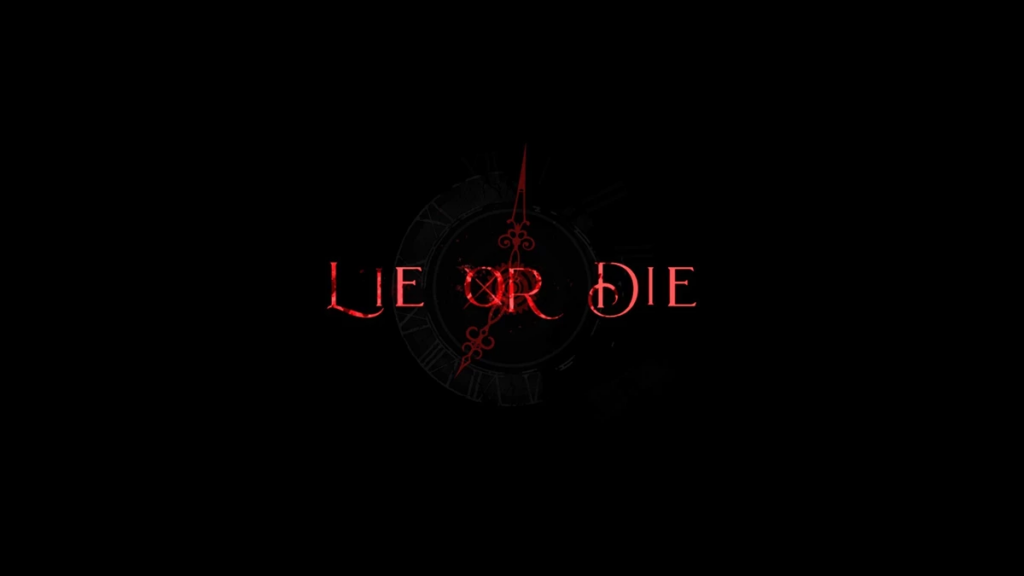
An actual death card. More like “pee or die trying” am i right???
Lies of P does present some good challenges, especially towards the end of the game, but it also deals a pretty heavy hand of bullshit like a lot of lesser soulslikes. Think item traps, ganky enemy placements, their own version of basilisks with an insta-kill status effect, that sort of thing. After a while it can feel old, but then you’re also expecting it around every corner, so the bullshit isn’t likely to get you. If anything, this is just slightly annoying—some levels and bosses have things that feel about as pointlessly annoying as the Nightmare Frontier in Bloodborne, but overall, I don’t feel like it really detracts from the game too much. My only real complaint would be that, when staggering late game bosses, they cease to just stagger and fall over for you to land a Fatal Attack, but manage to do one (or two) more attacks on their way down. Very annoying when you’re used to being able to rush in for the attack, but, again, not something you can’t learn to deal with.
Despite all this—and remember how dearly I hold the horny weird masochism of soulsborne games to my heart—Lies of P is still a solid 7.5/10 for me because it’s just that much fun to play. What the developers did not achieve in the game is a much, much smaller part of the game than its core component: just playing the game and having a good fucking time with it. It’s just great to play. It made me laugh a lot. Every time I got a quartz I yelled out “HELL YEAH I GET TO ACTIVATE MY P-ORGAN” and started laughing (all alone in my living room.) I got to be a killing machine in a frilly shirt, and I got a weapon with a fantastic polearm/staff move set that Fromsoft needs to pay attention to and put in their next goddamned game. I’m tired of getting a pole arm that has “poke” as its only move. Let me whip that bad boy around! It activates my p-organ!!!
There is—even after this nauseating word count of 4300 words—more I could say about it, but I’ll leave it here. If it piques your interest, go for it—it’s a good game.
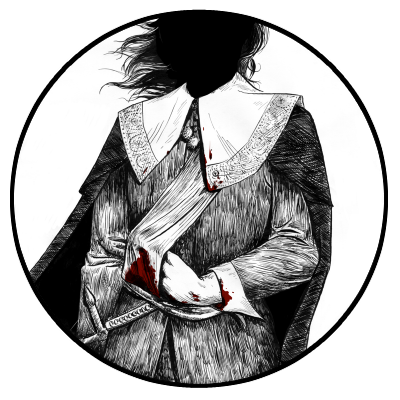
Leave a Reply